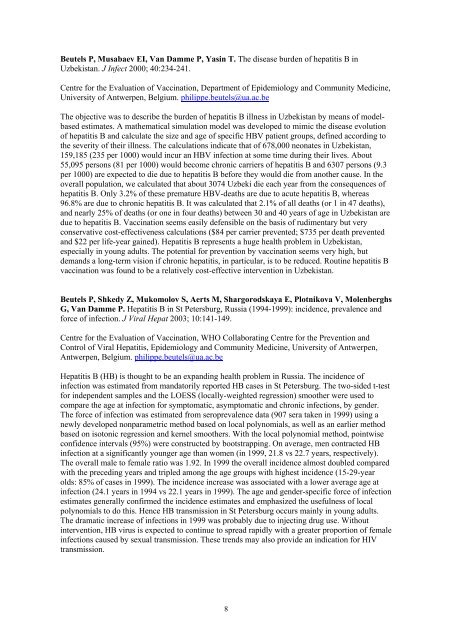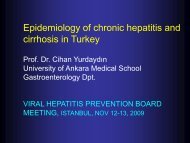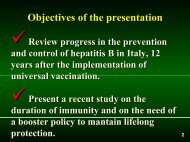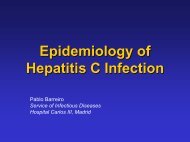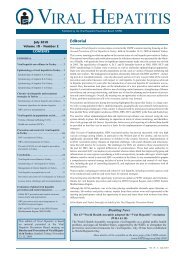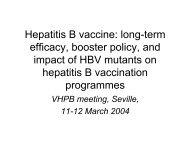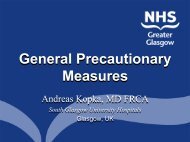Beutels P, Musabaev EI, Van Damme P, Yas<strong>in</strong> T. The disease burden <strong>of</strong> <strong>hepatitis</strong> B <strong>in</strong>Uzbekistan. J Infect 2000; 40:234-241.Centre for the Evaluation <strong>of</strong> Vacc<strong>in</strong>ation, Department <strong>of</strong> Epidemiology <strong>and</strong> Community Medic<strong>in</strong>e,University <strong>of</strong> Antwerpen, Belgium. philippe.beutels@ua.ac.beThe objective was to describe the burden <strong>of</strong> <strong>hepatitis</strong> B illness <strong>in</strong> Uzbekistan by means <strong>of</strong> modelbasedestimates. A mathematical simulation model was developed to mimic the disease evolution<strong>of</strong> <strong>hepatitis</strong> B <strong>and</strong> calculate the size <strong>and</strong> age <strong>of</strong> specific HBV patient groups, def<strong>in</strong>ed accord<strong>in</strong>g tothe severity <strong>of</strong> their illness. The calculations <strong>in</strong>dicate that <strong>of</strong> 678,000 neonates <strong>in</strong> Uzbekistan,159,185 (235 per 1000) would <strong>in</strong>cur an HBV <strong>in</strong>fection at some time dur<strong>in</strong>g their lives. About55,095 persons (81 per 1000) would become chronic carriers <strong>of</strong> <strong>hepatitis</strong> B <strong>and</strong> 6307 persons (9.3per 1000) are expected to die due to <strong>hepatitis</strong> B before they would die from another cause. In theoverall population, we calculated that about 3074 Uzbeki die each year from the consequences <strong>of</strong><strong>hepatitis</strong> B. Only 3.2% <strong>of</strong> these premature HBV-deaths are due to acute <strong>hepatitis</strong> B, whereas96.8% are due to chronic <strong>hepatitis</strong> B. It was calculated that 2.1% <strong>of</strong> all deaths (or 1 <strong>in</strong> 47 deaths),<strong>and</strong> nearly 25% <strong>of</strong> deaths (or one <strong>in</strong> four deaths) between 30 <strong>and</strong> 40 years <strong>of</strong> age <strong>in</strong> Uzbekistan aredue to <strong>hepatitis</strong> B. Vacc<strong>in</strong>ation seems easily defensible on the basis <strong>of</strong> rudimentary but veryconservative cost-effectiveness calculations ($84 per carrier prevented; $735 per death prevented<strong>and</strong> $22 per life-year ga<strong>in</strong>ed). Hepatitis B represents a huge health problem <strong>in</strong> Uzbekistan,especially <strong>in</strong> young adults. The potential for prevention by vacc<strong>in</strong>ation seems very high, butdem<strong>and</strong>s a long-term vision if chronic <strong>hepatitis</strong>, <strong>in</strong> particular, is to be reduced. Rout<strong>in</strong>e <strong>hepatitis</strong> Bvacc<strong>in</strong>ation was found to be a relatively cost-effective <strong>in</strong>tervention <strong>in</strong> Uzbekistan.Beutels P, Shkedy Z, Mukomolov S, Aerts M, Shargorodskaya E, Plotnikova V, MolenberghsG, Van Damme P. Hepatitis B <strong>in</strong> St Petersburg, Russia (1994-1999): <strong>in</strong>cidence, prevalence <strong>and</strong>force <strong>of</strong> <strong>in</strong>fection. J Viral Hepat 2003; 10:141-149.Centre for the Evaluation <strong>of</strong> Vacc<strong>in</strong>ation, WHO Collaborat<strong>in</strong>g Centre for the <strong>Prevention</strong> <strong>and</strong>Control <strong>of</strong> Viral Hepatitis, Epidemiology <strong>and</strong> Community Medic<strong>in</strong>e, University <strong>of</strong> Antwerpen,Antwerpen, Belgium. philippe.beutels@ua.ac.beHepatitis B (HB) is thought to be an exp<strong>and</strong><strong>in</strong>g health problem <strong>in</strong> Russia. The <strong>in</strong>cidence <strong>of</strong><strong>in</strong>fection was estimated from m<strong>and</strong>atorily reported HB cases <strong>in</strong> St Petersburg. The two-sided t-testfor <strong>in</strong>dependent samples <strong>and</strong> the LOESS (locally-weighted regression) smoother were used tocompare the age at <strong>in</strong>fection for symptomatic, asymptomatic <strong>and</strong> chronic <strong>in</strong>fections, by gender.The force <strong>of</strong> <strong>in</strong>fection was estimated from seroprevalence data (907 sera taken <strong>in</strong> 1999) us<strong>in</strong>g anewly developed nonparametric method based on local polynomials, as well as an earlier methodbased on isotonic regression <strong>and</strong> kernel smoothers. With the local polynomial method, po<strong>in</strong>twiseconfidence <strong>in</strong>tervals (95%) were constructed by bootstrapp<strong>in</strong>g. On average, men contracted HB<strong>in</strong>fection at a significantly younger age than women (<strong>in</strong> 1999, 21.8 vs 22.7 years, respectively).The overall male to female ratio was 1.92. In 1999 the overall <strong>in</strong>cidence almost doubled comparedwith the preced<strong>in</strong>g years <strong>and</strong> tripled among the age groups with highest <strong>in</strong>cidence (15-29-yearolds: 85% <strong>of</strong> cases <strong>in</strong> 1999). The <strong>in</strong>cidence <strong>in</strong>crease was associated with a lower average age at<strong>in</strong>fection (24.1 years <strong>in</strong> 1994 vs 22.1 years <strong>in</strong> 1999). The age <strong>and</strong> gender-specific force <strong>of</strong> <strong>in</strong>fectionestimates generally confirmed the <strong>in</strong>cidence estimates <strong>and</strong> emphasized the usefulness <strong>of</strong> localpolynomials to do this. Hence HB <strong>transmission</strong> <strong>in</strong> St Petersburg occurs ma<strong>in</strong>ly <strong>in</strong> young adults.The dramatic <strong>in</strong>crease <strong>of</strong> <strong>in</strong>fections <strong>in</strong> 1999 was probably due to <strong>in</strong>ject<strong>in</strong>g drug use. Without<strong>in</strong>tervention, HB <strong>virus</strong> is expected to cont<strong>in</strong>ue to spread rapidly with a greater proportion <strong>of</strong> female<strong>in</strong>fections caused by sexual <strong>transmission</strong>. These trends may also provide an <strong>in</strong>dication for HIV<strong>transmission</strong>.8
Boxall E. Screen<strong>in</strong>g <strong>of</strong> pregnant women for <strong>hepatitis</strong> B. Vacc<strong>in</strong>e 1998; 16(Suppl):S30-S33.Public Health Laboratory, Birm<strong>in</strong>gham Heartl<strong>and</strong>s Hospital, Bardesley Green East, UK.lboxall@cdscwmid.demon.co.ukNeonatal <strong>in</strong>fection with <strong>hepatitis</strong> B <strong>virus</strong> carries a very high risk <strong>of</strong> result<strong>in</strong>g <strong>in</strong> a persistent<strong>in</strong>fection. Babies born to <strong>hepatitis</strong> B carrier mothers are at risk <strong>of</strong> <strong>in</strong>fection through exposure toblood <strong>and</strong> body fluids dur<strong>in</strong>g birth. These 'at risk' babies can only be identified through screen<strong>in</strong>g<strong>of</strong> all mothers dur<strong>in</strong>g pregnancy. <strong>Prevention</strong> <strong>of</strong> <strong>in</strong>fection <strong>in</strong> this group is a key element <strong>in</strong> anynation's strategy to reduce the <strong>in</strong>cidence <strong>and</strong> eventually elim<strong>in</strong>ate <strong>hepatitis</strong> B <strong>in</strong>fection <strong>in</strong> itspopulation as the persistently <strong>in</strong>fected <strong>in</strong>fants are a reservoir <strong>of</strong> <strong>in</strong>fection throughout their lives.The <strong>in</strong>fected adult carries a relatively low risk <strong>of</strong> becom<strong>in</strong>g a chronic carrier (< 10%). Variousstrategies for screen<strong>in</strong>g <strong>in</strong> pregnancy have been adopted. These <strong>in</strong>clude attempts to identifywomen with a history <strong>of</strong> 'risk behaviour', test<strong>in</strong>g only women who were born <strong>in</strong> areas <strong>of</strong> highendemicity, pool<strong>in</strong>g <strong>of</strong> sera <strong>and</strong> universal antenatal screen<strong>in</strong>g. The advantages <strong>and</strong> disadvantages<strong>of</strong> the various strategies will be discussed.Boxall EH, Smith N. Antenatal screen<strong>in</strong>g for HIV; are those who refuse test<strong>in</strong>g at higher risk thanthose who accept test<strong>in</strong>g? J Public Health (Oxf) 2004; 26:285-287.National Blood Service, V<strong>in</strong>cent Drive, Edgbaston, Birm<strong>in</strong>gham B15 2SG, UK.elizabeth.boxall@nbs.nhs.ukThe UK Department <strong>of</strong> Health recommends that all pregnant women are <strong>of</strong>fered screen<strong>in</strong>g for<strong>in</strong>fection with human immunodeficiency <strong>virus</strong> (HIV) <strong>and</strong> had encouraged maternity units toachieve uptake targets <strong>of</strong> 90 per cent by the end <strong>of</strong> 2002. Many maternity units fail to meet thistarget <strong>and</strong> there is concern that those women who are still refus<strong>in</strong>g test<strong>in</strong>g may <strong>in</strong>clude a higherproportion <strong>of</strong> women at high risk <strong>of</strong> <strong>in</strong>fection. In consequence, those <strong>in</strong>fected with HIV are notbe<strong>in</strong>g identified <strong>and</strong> are not receiv<strong>in</strong>g the antiviral treatment, which would be <strong>of</strong> benefit to them<strong>and</strong> reduce the risk <strong>of</strong> <strong>transmission</strong> <strong>of</strong> HIV to their babies. A retrospective audit <strong>of</strong> HIV screen<strong>in</strong>guptake <strong>in</strong> women who were found to be <strong>in</strong>fected with <strong>hepatitis</strong> B <strong>virus</strong> (HBV) <strong>and</strong> <strong>in</strong> those whowere not <strong>in</strong>fected with HBV was carried out <strong>in</strong> order to explore further the characteristics <strong>of</strong>'acceptors' <strong>and</strong> 'refusers' <strong>of</strong> HIV screen<strong>in</strong>g. The overall uptake rate <strong>of</strong> HIV screen<strong>in</strong>g <strong>in</strong> the WestMidl<strong>and</strong>s population served by the National Blood Service was 60 per cent <strong>in</strong> 2001 <strong>and</strong> 74 per cent<strong>in</strong> 2002. The prevalence <strong>of</strong> HBV <strong>in</strong>fection was found to be twice as high (0.39 per cent) <strong>in</strong> thosewho had refused an HIV test compared with those who had accepted a test (0.21 per cent) (p =0.022). There is good evidence that women refus<strong>in</strong>g HIV antenatal screen<strong>in</strong>g have a higherprevalence <strong>of</strong> another blood-borne <strong>virus</strong>, <strong>in</strong>dicat<strong>in</strong>g clearly that further effort must be made to<strong>in</strong>crease the screen<strong>in</strong>g uptake <strong>and</strong> fully <strong>in</strong>tegrate HIV screen<strong>in</strong>g with other antenatal tests.Burk RD, Hwang LY, Ho GY, Shafritz DA, Beasley RP. Outcome <strong>of</strong> <strong>per<strong>in</strong>atal</strong> <strong>hepatitis</strong> B <strong>virus</strong>exposure is dependent on maternal <strong>virus</strong> load. J Infect Dis 1994; 170:1418-1423.Marion Bess<strong>in</strong> Liver Research Center, Albert E<strong>in</strong>ste<strong>in</strong> College <strong>of</strong> Medic<strong>in</strong>e, Bronx, New York10461.To evaluate the role <strong>of</strong> maternal <strong>hepatitis</strong> B <strong>virus</strong> (HBV) DNA levels <strong>in</strong> <strong>per<strong>in</strong>atal</strong> <strong>in</strong>fection, twonested case-<strong>control</strong> studies were done with<strong>in</strong> a cohort <strong>of</strong> 773 <strong>hepatitis</strong> B surface antigen (HBsAg)-positive Taiwanese women <strong>and</strong> their <strong>in</strong>fants. As serum HBV DNA levels <strong>in</strong>creased from < 0.005to > or = 1.4 ng/ml among the <strong>hepatitis</strong> B e antigen (HBeAg)-positive mothers, the odds ratio (OR)for hav<strong>in</strong>g a persistently <strong>in</strong>fected <strong>in</strong>fant <strong>in</strong>creased from 1.0 to 147.0 (P for trend < 0.001). AmongHBeAg-negative mothers, the OR for hav<strong>in</strong>g a persistently <strong>in</strong>fected <strong>in</strong>fant was 19.2 (95%confidence <strong>in</strong>terval, 2.3-176.6) <strong>in</strong> mothers with high versus low levels <strong>of</strong> serum HBV DNA. A9
- Page 1 and 2: Pre-meeting documentPrevention and
- Page 3 and 4: Part I Prevention and control of pe
- Page 5 and 6: prevalence was significantly higher
- Page 7: clusters (obstetrics wards/hospital
- Page 11 and 12: Chang MH, Hsu HY, Huang LM, Lee PI,
- Page 13 and 14: of infection in infants and childre
- Page 15 and 16: Eriksen EM, Perlman JA, Miller A, M
- Page 17 and 18: liver enzyme abnormalities than wer
- Page 19 and 20: health care, is feasible and achiev
- Page 21 and 22: HBsAg and anti-HBs in 4.5%. In the
- Page 23 and 24: immunoprophylaxis. Reflecting effec
- Page 25 and 26: Levin CE, Nelson CM, Widjaya A, Mon
- Page 27 and 28: Delaying vaccination of premature i
- Page 29 and 30: diagnosis. In the past, the inciden
- Page 31 and 32: shows that the prevalence of HBV in
- Page 33 and 34: Niu MT, Targonski PV, Stoll BJ, Alb
- Page 35 and 36: Ranger-Rogez S, Alain S, Denis F. H
- Page 37 and 38: vaccinees) and low reactogenicity o
- Page 39 and 40: single ELISA test is about Rs40. At
- Page 41 and 42: newborns with surface antigenemia,
- Page 43 and 44: Wang Z, Zhang J, Yang H, Li X, Wen
- Page 45 and 46: of hepatitis B vaccine. This study
- Page 47 and 48: transmission has been estimated at
- Page 49 and 50: at birth and 2 weeks after birth, f
- Page 51 and 52: Chubinishvili OV, Mikhailov MI, Sak
- Page 53 and 54: Jensen L, Heilmann C, Smith E, Want
- Page 55 and 56: Onishchenko GG. Incidence of infect
- Page 57: Zanetti A, Tanzi E, Semprini AE. He


